What’s better than one fiddle leaf fig (ficus lyrata)? Several fiddle leaf fig plants!
If you own a plant, then you’re probably no stranger to the process of propagation, and who doesn’t want to add more fiddle leaf figs to their plant collection?!
Fiddle leaf fig propagation is an easy, cheap, and effective way to help multiply your plant count without have to go buy a whole new plant!
Although there are many different ways to propagate a fiddle leaf, in this blog post, we’ll be going over the two main types of propagation for a fiddle leaf fig: water propagation and soil propagation. We’ll share how to successfully propagate fiddle fig trees, as well as helpful tips on how to care for your new fiddle leaf.
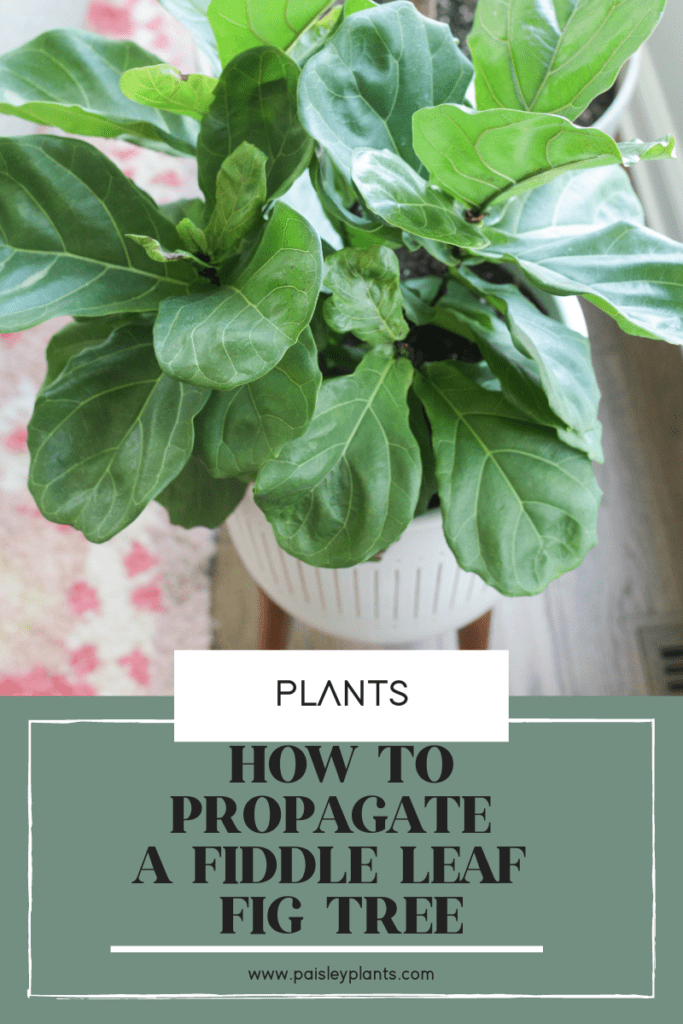
Table of Contents
Materials Needed to Propagate a Fiddle Leaf Fig
Propagating a new fiddle leaf fig is easy and affordable, but it does require a small list of supplies in order to have a successful propagation.
Here are the materials you will need to propagate a fiddle leaf fig:
- Pruning shears; sharpened and clean
- Small plant pot with drainage holes
- Well-draining potting soil
- Hormone rooting powder (optional)
- Glass jar (water propagation only)
- Clear plastic bag (soil propagation only)
Cuttings – Where & How to Cut
Before you start cutting, you should know when to cut. The best time to propagate your plant is during the growing season. This will give you the best results possible since they’re actively growing and not dormant.
Now on to cutting! Getting good leaf cuttings is the first step to a successful propagation, whether it be in soil or in water. Pay close attention to the amount of cuttings needed when you propagate this houseplant.
To start this houseplant propagation process, select a branch from the fig tree that is healthy; there should be no obvious signs of disease or damage.
Ideally, you should find a branch with woody stems that contains at most 2 to 3 leaves on it; don’t worry if you don’t have a branch that matches that description, you can always remove the excess lower leaves. Make sure to keep the stem cuttings at least 6 inches long.
Take your clean pruning shears; you’ll want to be sure that the shears you are using are sharp and sterile as not to spread any residual bacteria to the leaves on the plant.
Make a diagonal cut on the stem; a diagonal cut is helpful in creating the most surface area allowing your fiddle leaf fig plant to absorb enough water.
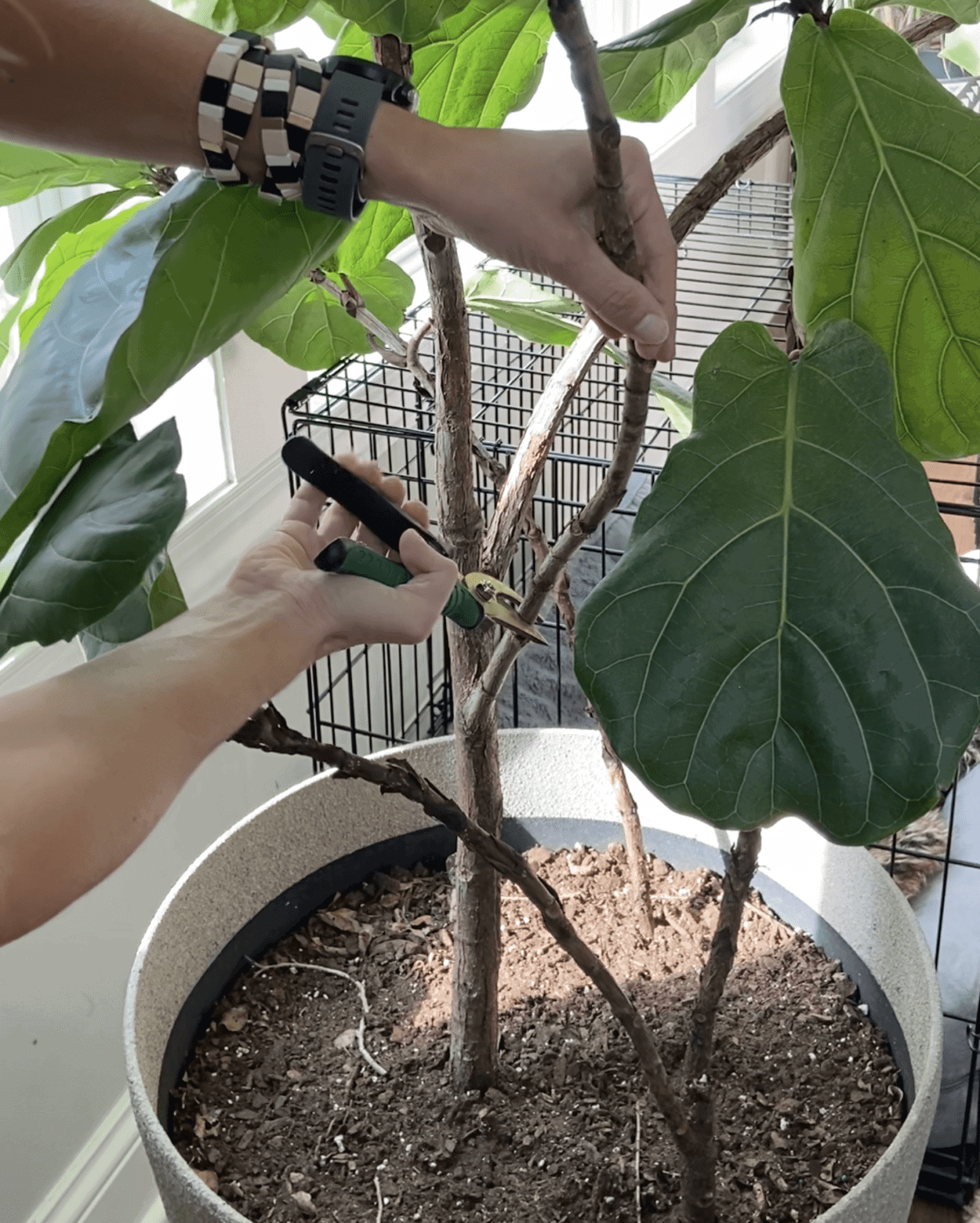
Propagating a Fiddle Leaf Fig in Soil
There is more than one propagation method when it comes to propagating fiddle-leaf figs. The first method that many people gravitate towards is the soil method, which is incredibly straightforward when it comes to the propagate process.
It involves directly planting your fiddle leaf cuttings into a pot of soil and waiting for the roots to form.
Follow these steps on how to propagate your plant in soil:
- Prepare a small pot with well-draining soil. This soil should be watered long ahead of time. Make sure it is moist soil but not waterlogged.
- Take your cutting and dust it with rooting hormone powder. This is a completely optional step, but do keep in mind that rooting powder can help significantly increase the success rate. Many garden retailers sell hormone rooting powder, or you can find it online.
- Bury your plant cutting in the soil, making sure that at least 1 to 2 inch section of the stem is under the soil. The leaves should be upright and above the surface of the soil. Do not bury the leaves on the cuttings, they need to have air circulation in between them in order to prevent the risk of rotting – this is one of the most important things to remember during the fiddle leaf fig propagation process.
- Cuttings from the fiddle leaf fig that are propagated in soil tend to absorb less moisture. To help increase moisture levels, it is helpful to cover your plant with a clear plastic bag. The bag will help create a greenhouse effect for the plant. Not only does it assist with moisture-retention, but also creates a warmer environment.
- Keep your pot in an area of the house that receives bright, indirect light. if they’re given too much direct sunlight too quickly, the leaves could burn and form brown scorch marks. Make sure to maintain an even level of moisture in the soil, but avoid overwatering your fiddle leaf fig as this can spoil the process.
- It takes about 1 to 2 months for the plant to establish itself and get rooted in its container. A good sign of a successful fiddle leaf fig propagation is new foliage growth. If you give the branch a little tug and you’re met with any resistance, then that means that the branch has grown roots and established itself!
Propagating a Fiddle Leaf Fig in Water
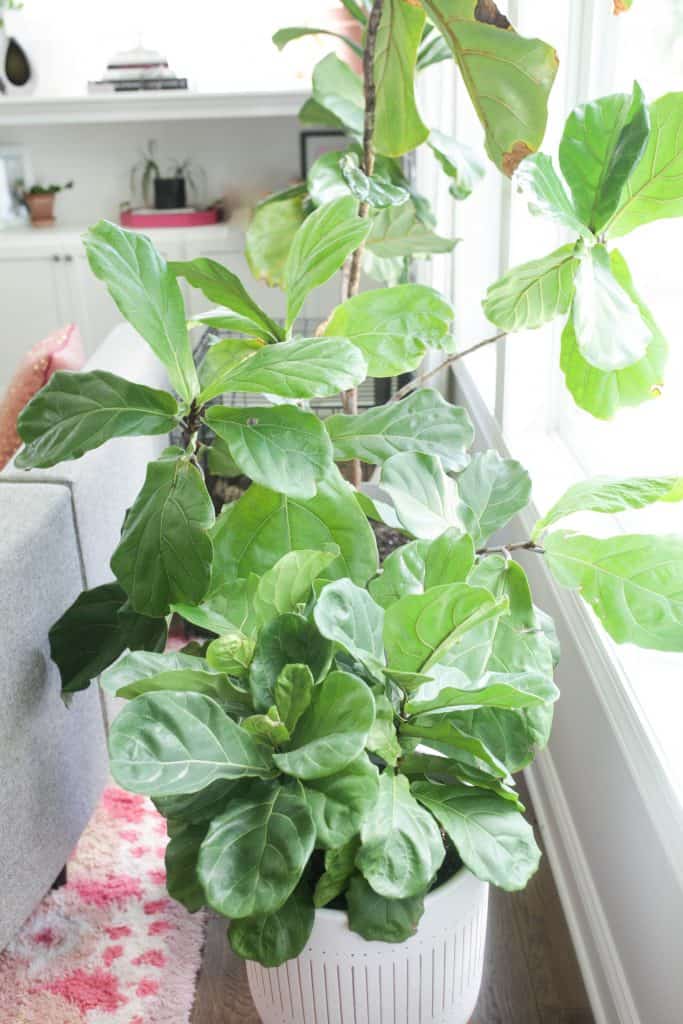
Propagating your fiddle-leaf fig in water is very similar to that of propagating in soil. The main difference when you use this method to propagate, is that you place your branch in a jar of water and wait for roots to form before transferring into soil.
I find this to be the easiest way to propagate my indoor plants because I can see exactly when roots are forming!
Check out these stunning propagation stations!
The main pro of propagating in water is that you can monitor how fast and how long the roots grow in the water.
Follow these steps to successfully propagate your plant via water:
- Fill a clean jar with water with room temperature water. Ideally you want to use distilled water or water that has been sitting out for 24 hours. Preferably, this jar should be small/medium. When a plant is propagated, they release their own natural growth hormones into the water. By choosing a smaller container, this will help concentrate the hormone and will be helpful when you start to propagate.
- Place the branch in the jar of water, making sure that the cut-end is entirely submerged. Do not allow the leaves to get wet, as this can increase the odds of failure. Instead, try to make sure that half the branch and leaves are above the rim of the jar; this will help increase airflow throughout the plant, and help you when you are going to propagate.
- Keep your fiddle leaf fig jar in a warm location that receives bright, indirect light. If they’re given too much direct sunlight too quickly, the leaves could burn and form brown scorch marks.
- It takes about a month to see new roots coming from the branch. Wait until the root growth is at least 1 inch in length before you move onto the next step.
- Prepare a small plant pot with well-draining soil. Make sure the soil is evenly moist, but not soaked in water.
- Transplant the cutting into the new soil; please ensure that the cutting is standing upright and is firmly and securely in the soil in order to grow its roots and develop a root system properly.
- Keep the plant pot in a bright location and maintain an even level of moisture for the next few weeks while the propagated fiddle leaf fig cutting grows accustomed to its new environment, pot, and get rooted.
Fiddle Leaf Fig Care After Propagation
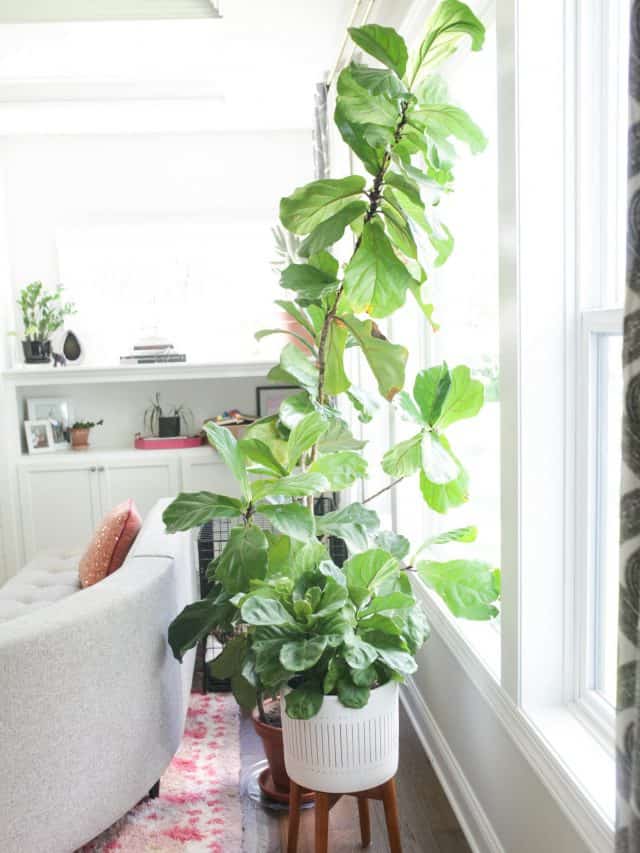
After a month or so post propagating your fiddle leaf figs, your juvenile fiddle leaf fig should probably be transplanted into a new slightly larger container in order to encourage new growth.
You’ll want to size up your new plant pot very gradually, I would recommend something that is between 2 to 4 inches larger than the previous one.
During the first few weeks of its life, it is important to maintain an even level of soil moisture. This is done to prevent transplant shock from ruining your new propagation growth process.
However, when your houseplant is established, you can safely space out waterings. Ideally, you should wait for the soil to partially dry up before rehydrating your plant.
Temperature & Humidity
As tropical plants, it is essential to maintain a specific temperature and humidity level for your fiddle leaf fig. A room temperature that is in between 55° to 85° F is the ideal range for this plant.
Avoid anything lower than 55° and refrain from placing your plant near an air conditioning vent system or a drafty window.
As for humidity, maintaining a humidity level of around 50% is ideal to keep your plants happy, but at the very least you should aim between 30% and 65%.
A lack of humidity is associated with browning, crunchy leaves on the plants. Consider using a moisture meter to see if your fiddle leaf fig is thriving in its environment.
Fertilizer
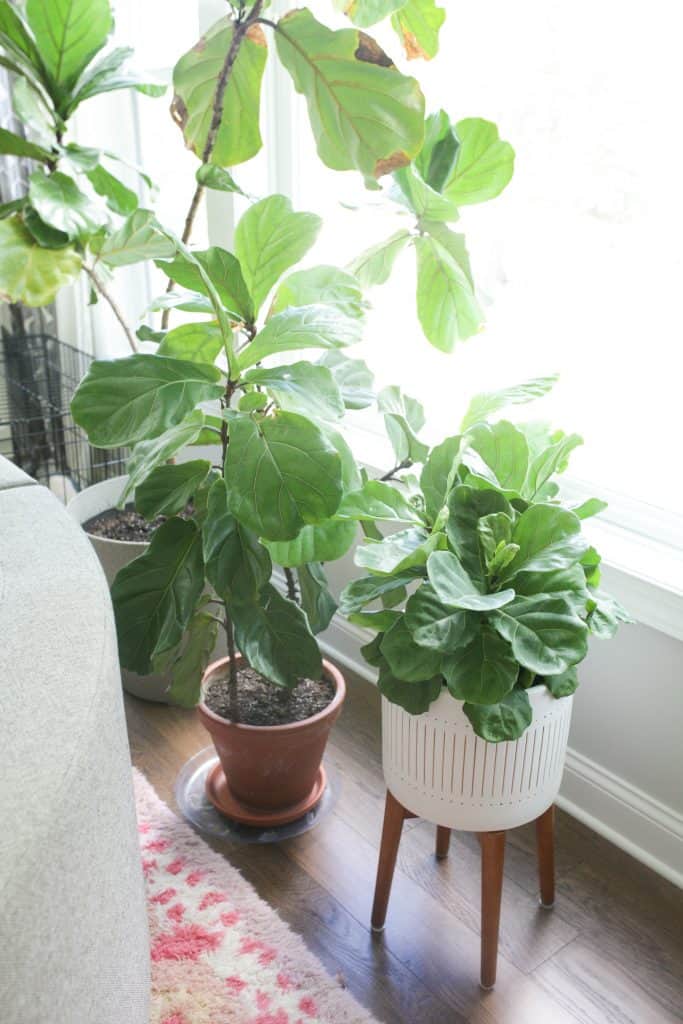
Fertilizing your plant is a necessary step in encouraging new growth.
We recommend only fertilizing your plant during the spring and summer, when your fiddle leaf fig tree is in its active growing period.
Do not fertilize your plants at all during fall and winter, as the unused fertilizer mix could acidify the leaf figs soil to an unsafe pH level.
Select a fertilizer that has a higher content in nitrogen for these types of plants.
Nitrogen is the element associated with developing strong foliage growth and acts as hearty fig plant food for your newly propagated plants.
Follow the label instructions and feed your plants about once a month throughout the spring and summer months, in order to keep it on a healthy growth cycle.
Pruning
Occasional pruning of the leaves is also helpful in encouraging new, healthy growth on the plants. You’ll always want to prune any parts of the plants that is diseased or damaged.
By removing these unnecessary pieces of foliage, you’ll allow your plant to redirect its energy towards developing new clean growth.
The more leaves your fiddle leaf fig has, the more light it will need to maintain its leaves and continue to grow new leaves.
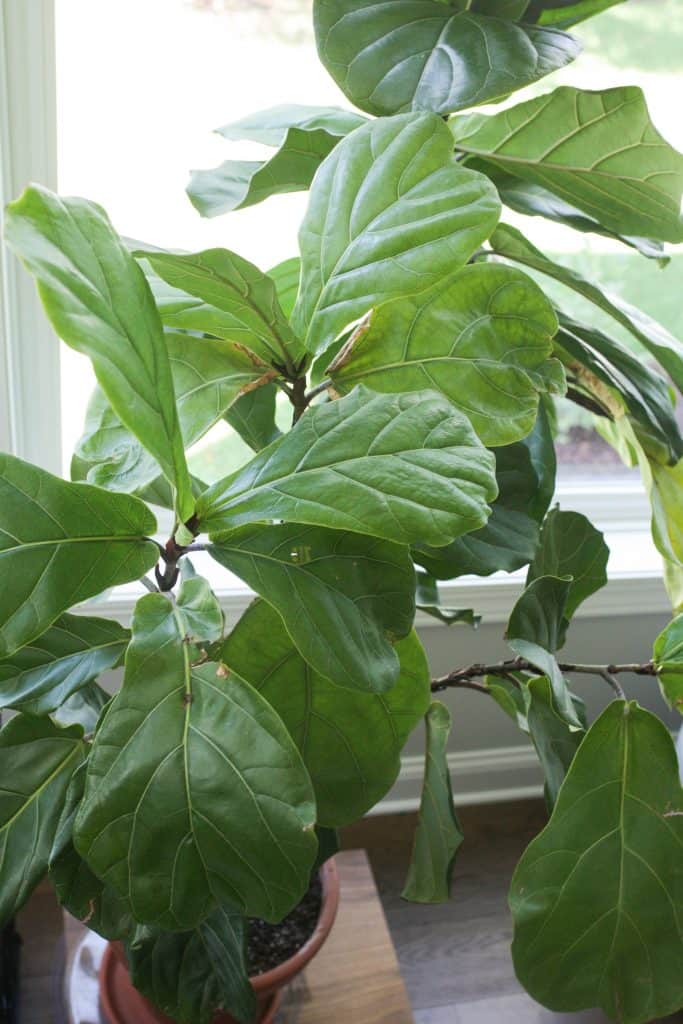
Conclusion
Propagation is about as close to magic as you can get! It’s one of my favorite ways to multiple your plants without breaking the bank and constantly buying new plants at the nursery.
Propagation may seem technical or complex, but it’s actually a fairly easy growth process.
With a few simple supplies and some patience, you can turn your beloved fiddle leaf fig into a whole new plant to gift to a loved one or if you want, simply keep it as a houseplant to enjoy for years to come!
Looking for more Fiddle Leaf fun? Head on over to these posts!

